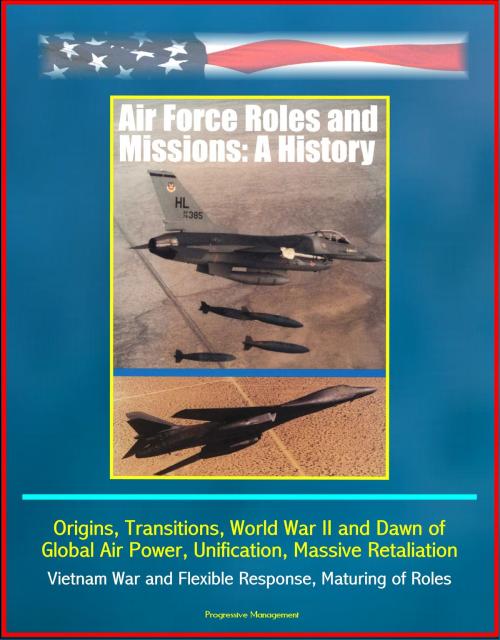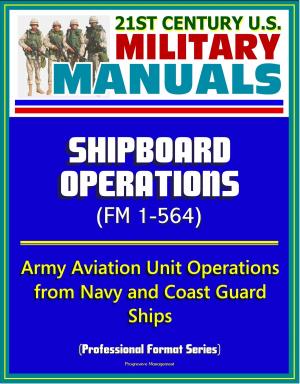Air Force Roles and Missions: A History - Origins, Transitions, World War II and Dawn of Global Air Power, Unification, Massive Retaliation, Vietnam War and Flexible Response, Maturing of Roles
Nonfiction, History, Military, Aviation, World War II| Author: | Progressive Management | ISBN: | 9781311341525 |
| Publisher: | Progressive Management | Publication: | June 13, 2015 |
| Imprint: | Smashwords Edition | Language: | English |
| Author: | Progressive Management |
| ISBN: | 9781311341525 |
| Publisher: | Progressive Management |
| Publication: | June 13, 2015 |
| Imprint: | Smashwords Edition |
| Language: | English |
Professionally converted for accurate flowing-text e-book format reproduction, this unique USAF publication traces the doctrinal underpinnings of the modern United States Air Force, the world's only global air force. The men and women who serve in the Air Force, and airmen in America's other military services, are the heirs and beneficiaries of a long heritage of doctrinal development and military thought. The twentieth century witnessed the emergence of three-dimensionality in war: surface forces now became prey for attackers operating above and below the earth and its oceans. The aerial weapon, prophesied for centuries, became a reality, as did air power projection forces.
"Our predecessors pursued a vision of airborne global reach and power that often put them at odds with those who could not break free of the confines of conventional thought and lock-step traditionalism. Fortunately, they had the courage of their convictions and the faith in their vision to continue to pursue the goal of global air power despite such resistance. Today, America is a genuine aerospace power, and that pioneering vision dating to the days of the Wright brothers, has expanded to encompass operations in space and between the mediums of air and space. As we approach the new millenium, it is well to ponder the lessons and the history of how a small group of truly gifted airmen transformed their nation's military establishment, and, in so doing, the world around them."
Chapter I - Origins: Emerging Military Aviation Roles * Chapter II - Transitions: Evolving Interwar Roles and Missions * Chapter III - Patterns: World War II and the Dawn of Global Air Power * Chapter IV - Foundations: Framing Roles and Missions under Unification * Chapter V - New Dimensions: the Air Force and Massive Retaliation * Chapter VI - New Directions: the Vietnam War and Flexible Response * Chapter VII - Change and Consequence: the Maturing of Roles and Missions
When this volume was conceived, no official definition of roles and missions existed. As the volume progressed, however, intense scrutiny of the subject emanating from the Goldwater-Nichols Reorganization Act of 1986 and the winding down of the Cold War stimulated an active interest in formal terminology. The search for formal definition added to the roles and missions lore, but it did not affect this work. The popular military usage and meaning of roles and missions long ago became commonplace in official documents and military literature. Accepted usage dating from the post-World War II period established the synonymity of the phrase roles and missions with the legally framed functions of the armed forces, as set forth by executive order pursuant to the National Security Act of 1947. Approved by President Harry S. Truman on July 28, 1947, that landmark legislation created the United States Air Force and unified the armed forces under the National Military Establishment and later the Department of Defense (DOD). The Act failed, however, to end bitter interservice feuding over roles and missions which began with the birth of military aviation in 1907 and intensified over the intervening years. The phrase roles and missions actually predates the National Security Act of 1947-appearing often in unification debates which preceded the law's enactment. Documents from this period show military officers using the phrase frequently when expressing their views on the functions of the armed forces. While defending the Army Air Forces before congressional hearings in March 1947, Gen. Carl A. Spaatz challenged a Navy proposal to delineate the services' functions in pending legislation-arguing persuasively that the President "prescribes the roles and missions of the Army, Navy, and Air Forces." When Dwight D. Eisenhower and other top Army generals agreed, Spaatz's argument prevailed.
Professionally converted for accurate flowing-text e-book format reproduction, this unique USAF publication traces the doctrinal underpinnings of the modern United States Air Force, the world's only global air force. The men and women who serve in the Air Force, and airmen in America's other military services, are the heirs and beneficiaries of a long heritage of doctrinal development and military thought. The twentieth century witnessed the emergence of three-dimensionality in war: surface forces now became prey for attackers operating above and below the earth and its oceans. The aerial weapon, prophesied for centuries, became a reality, as did air power projection forces.
"Our predecessors pursued a vision of airborne global reach and power that often put them at odds with those who could not break free of the confines of conventional thought and lock-step traditionalism. Fortunately, they had the courage of their convictions and the faith in their vision to continue to pursue the goal of global air power despite such resistance. Today, America is a genuine aerospace power, and that pioneering vision dating to the days of the Wright brothers, has expanded to encompass operations in space and between the mediums of air and space. As we approach the new millenium, it is well to ponder the lessons and the history of how a small group of truly gifted airmen transformed their nation's military establishment, and, in so doing, the world around them."
Chapter I - Origins: Emerging Military Aviation Roles * Chapter II - Transitions: Evolving Interwar Roles and Missions * Chapter III - Patterns: World War II and the Dawn of Global Air Power * Chapter IV - Foundations: Framing Roles and Missions under Unification * Chapter V - New Dimensions: the Air Force and Massive Retaliation * Chapter VI - New Directions: the Vietnam War and Flexible Response * Chapter VII - Change and Consequence: the Maturing of Roles and Missions
When this volume was conceived, no official definition of roles and missions existed. As the volume progressed, however, intense scrutiny of the subject emanating from the Goldwater-Nichols Reorganization Act of 1986 and the winding down of the Cold War stimulated an active interest in formal terminology. The search for formal definition added to the roles and missions lore, but it did not affect this work. The popular military usage and meaning of roles and missions long ago became commonplace in official documents and military literature. Accepted usage dating from the post-World War II period established the synonymity of the phrase roles and missions with the legally framed functions of the armed forces, as set forth by executive order pursuant to the National Security Act of 1947. Approved by President Harry S. Truman on July 28, 1947, that landmark legislation created the United States Air Force and unified the armed forces under the National Military Establishment and later the Department of Defense (DOD). The Act failed, however, to end bitter interservice feuding over roles and missions which began with the birth of military aviation in 1907 and intensified over the intervening years. The phrase roles and missions actually predates the National Security Act of 1947-appearing often in unification debates which preceded the law's enactment. Documents from this period show military officers using the phrase frequently when expressing their views on the functions of the armed forces. While defending the Army Air Forces before congressional hearings in March 1947, Gen. Carl A. Spaatz challenged a Navy proposal to delineate the services' functions in pending legislation-arguing persuasively that the President "prescribes the roles and missions of the Army, Navy, and Air Forces." When Dwight D. Eisenhower and other top Army generals agreed, Spaatz's argument prevailed.















